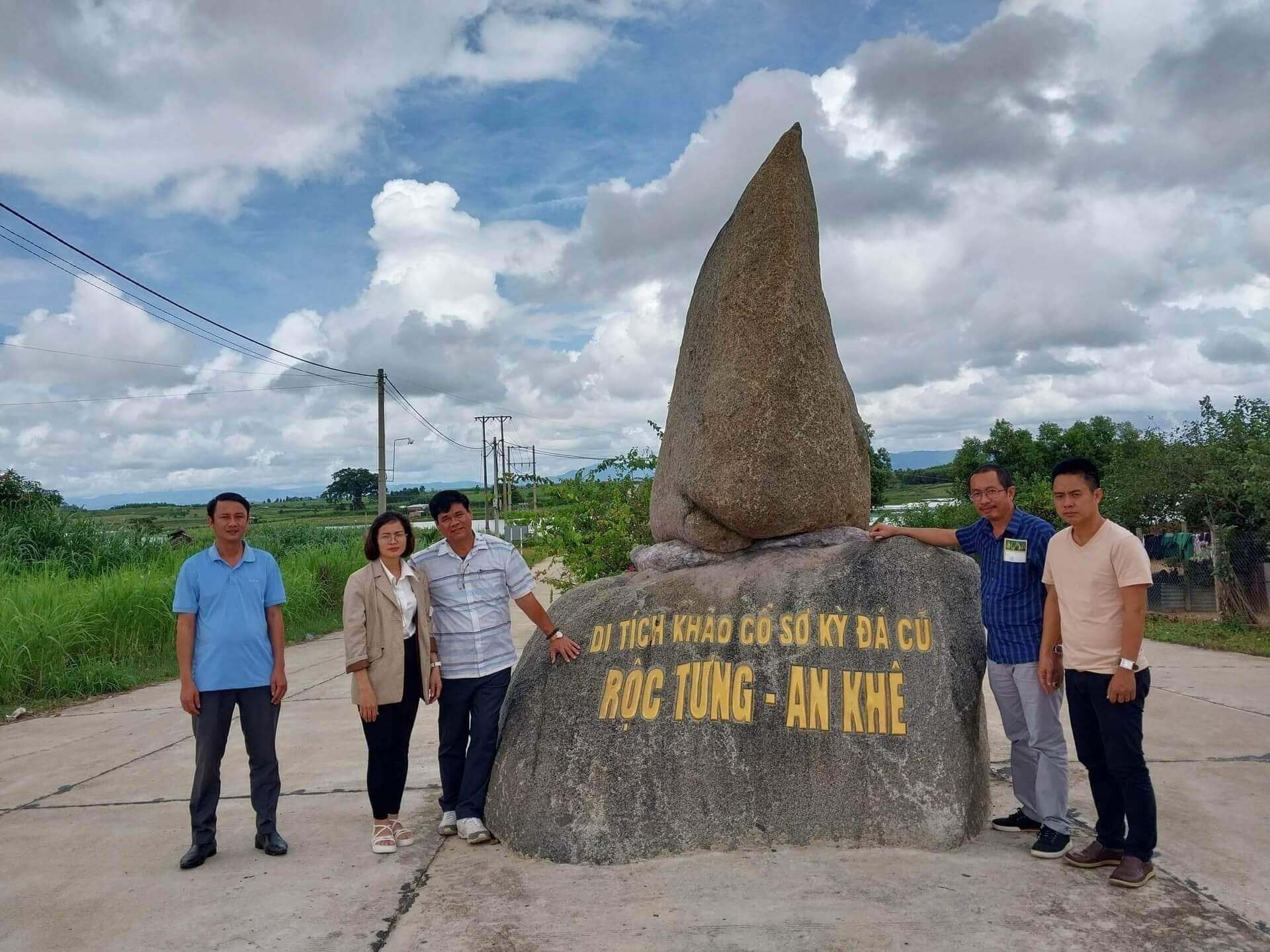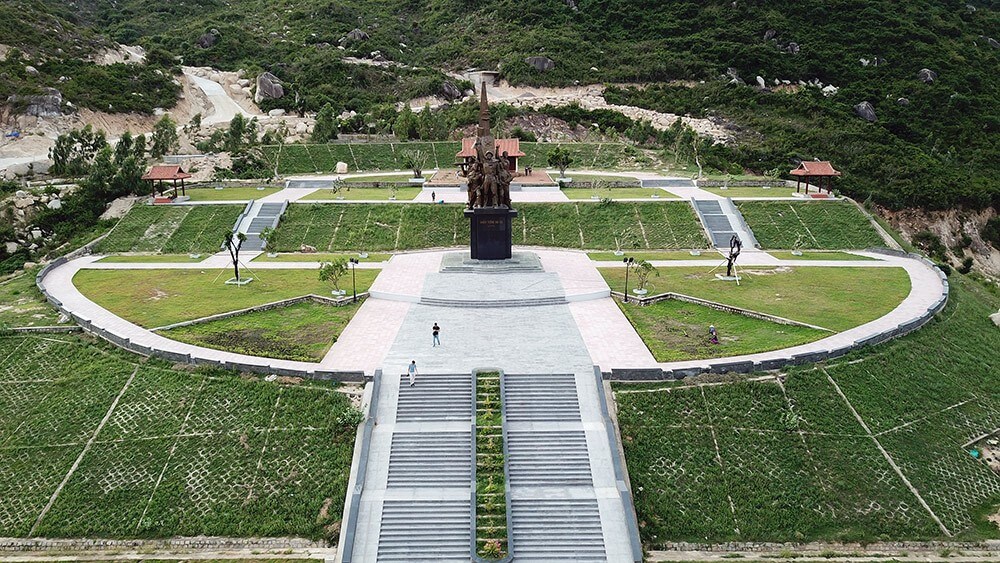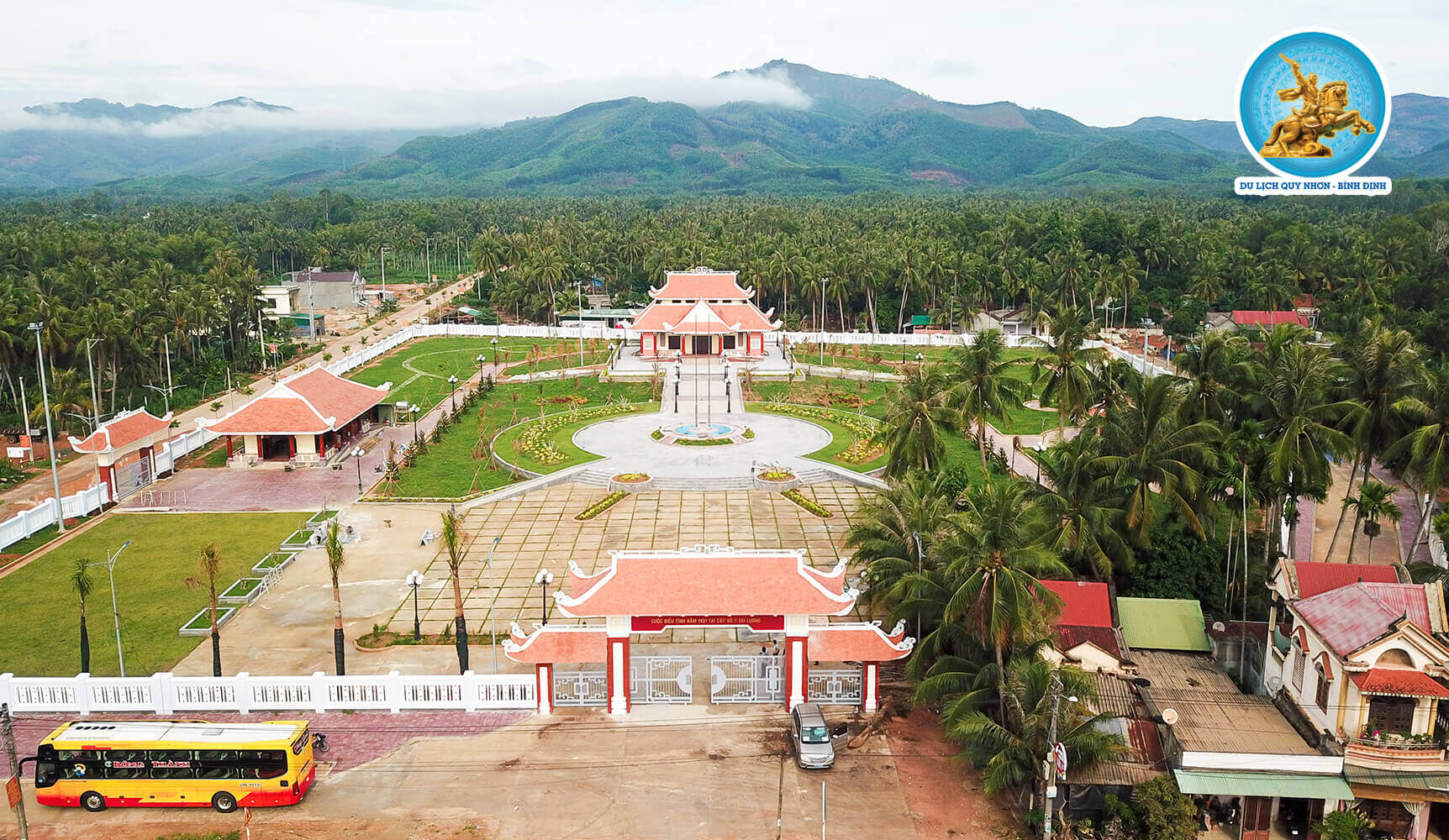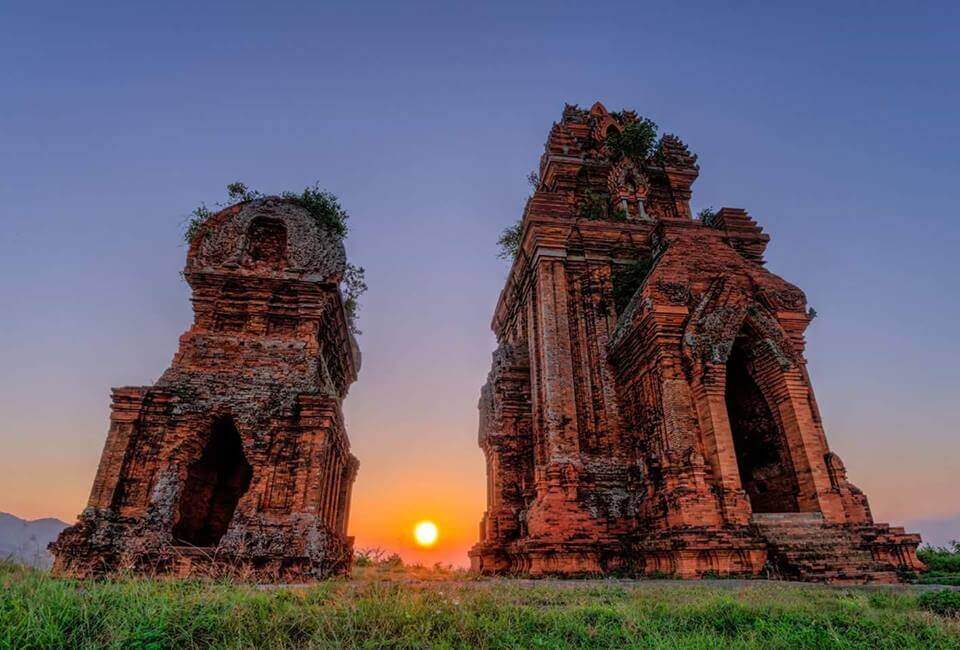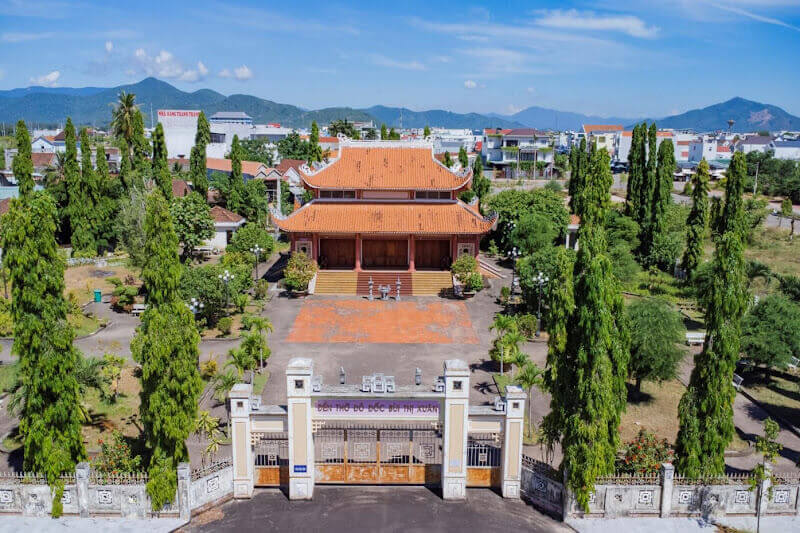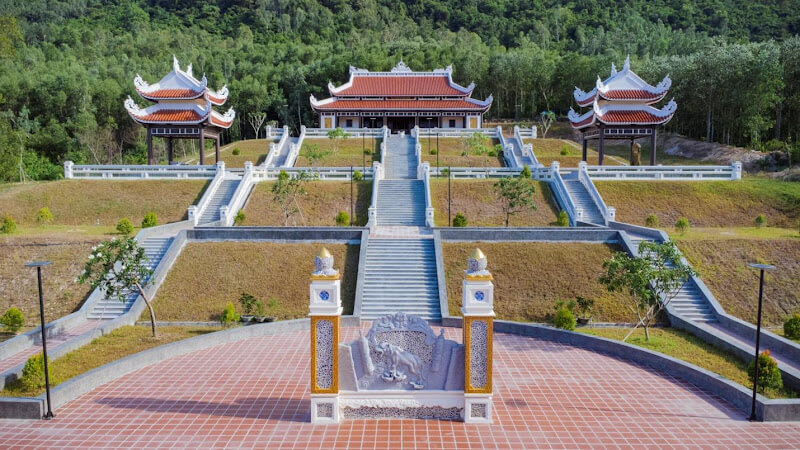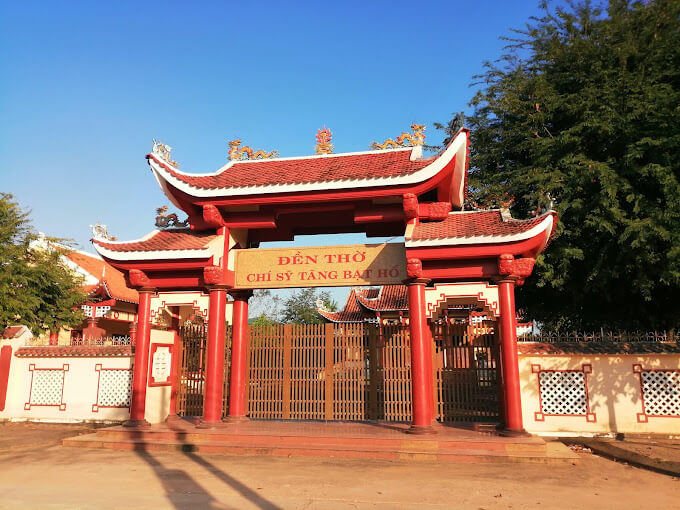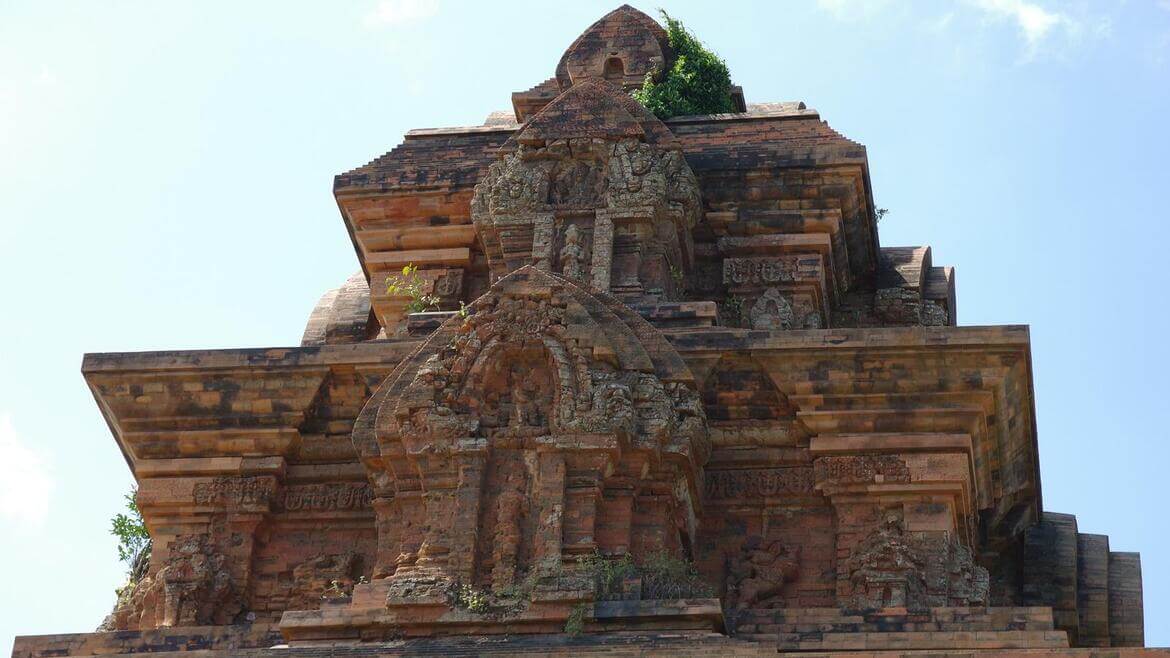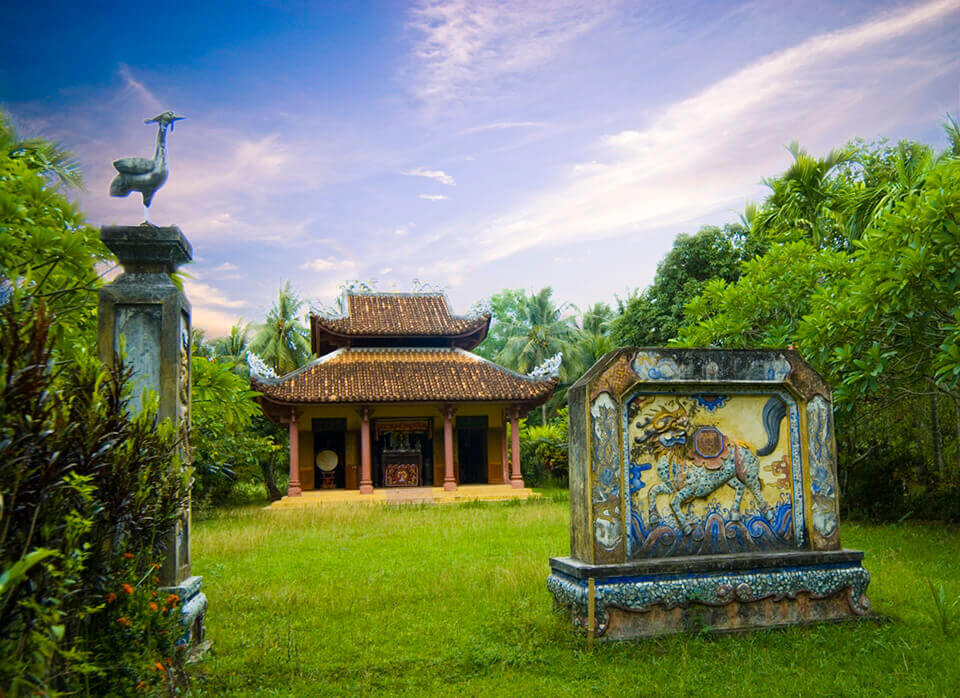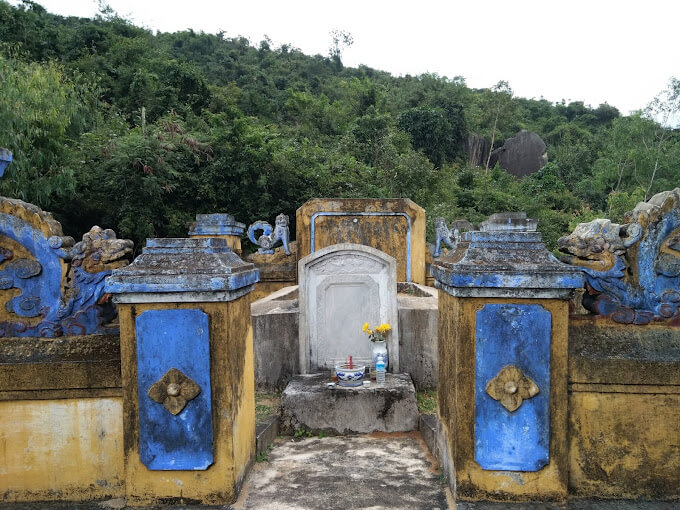Relic point Vietnam
Việt NamRich Tung - Go Da
Located in An Khe Town, Gia Lai Province, the old Rich Tung - Go Da Monument complex includes Go Da relics in An Binh ward and 12 Roc Tung relics in Xuan An commune, An Khe town, Gia Lai province. In particular, 4 places excavated are Go Da, Rich Tung 1, Rich Tung 4 and Rich Tung 7. The rest are all excavated and confirmed in the same complex with Ram Tung - Go Da. Stone Located in An Binh ward, An Khe town, Gia Lai province, with coordinates 13058’19,2 ”North latitude, 1080 39’05,1” Kinh Dong, absolute height of 421.5m. The monument is located on the right bank and about 1.5 km from the Ba River, in the hill terrain of the Ba River, which is worn out to accumulate, the elementary dating back wing (Qi). The monument was excavated twice (2015 and 2016), with a total area of 94m2, by the Department of Culture, Sports and Tourism of Gia Lai Province in collaboration with the Vietnam Institute of Archeology and the Institute of Archeology and Ethnology of Novosibirsk of the Russian Academy of Sciences. The mound relics have 1 cultural layer, made from granite in place, containing stone tools and meteorite. Some common characteristics: Most of them are made from quartz, quartzite, large size, outstanding type is a two -sided tip, three -sided spearhead, grated tools, tight tools, pieces of depression, hon ghec, baseball ... are rudimentary, less tuning, other shapes and more ancient than old stone monuments currently known in Vietnam such as Duh Dam (Thanh Hoa). The stone is a relics, manipulating the tools of the old stone residents, at the stage of the Homo Erectus, in the evolution of humanity from here to modern people (Homo sapiens) and is the first cultural evidence of humanity. Rush 1 Located in Xuan An commune, with coordinates 14002’25,3 "North latitude, 1080 40’82,2” Kinh Dong, absolute height of 556m. Located on the left bank and about 2.5km from the Ba River, excavated 3 times (2016, 2017 and 2018); In 2016, excavating holes 1 with an area of 48m2 (6m x 8m); In 2017, excavating holes 2 with an area of 70m2 (10m x 7m), chosen to build a display house on the spot when digging to grade 1.2. at a depth of 0.8m -1.1m (cultural highway); In 2018, excavated 20m2 within 70m2 of hole 2, at a depth of layer 2.2. The remaining 50m2 is preserved in the roof. Rich Tung 1 is a residence relic and place of manipulation, of which the element of residence is quite typical, shown on the surface of the cultural floor, there are a number of stone clusters, solid, higher bonds around, in which high concentration of quartz stone pieces, some stone lymph nodes, pieces of depression and crushed tools. The ruins of the ruins 1, in terms of basic geological structure like Go Da, belongs to the pleistocene period, about the characteristics of the existence of the two -sided ghost tools, all one -sided, pointed nose, scraping, choppers ... with an old stone characteristic. Rich Tung 1 is a residence relic and place of manipulation, of which the element of residence is quite typical, shown on the surface of the cultural floor, there are a number of stone clusters, solid, higher bonds around, in which high concentration of quartz stone pieces, some stone lymph nodes, pieces of depression and crushed tools. Rush 4 Located at the coordinates of 14002’2,7 "North latitude and 108040’35,7” Kinh Dong, 430m high, located about 500m from Ro Rot 1 and on the left bank of the Ba River. The monument was detected in November 2015 and excavated in 2016, 2017 and 2018. The results of the 4 -pit excavation in Roc Xung 4 relic showed that the holes had stratified structure, the same characteristics, reflecting the properties of residence and manufacturing tools. The stone tool complex in the locations of Tung 4 is basically like Rich Tung 1 and Go Da. Tung 7 Located in Xuan An commune, An Khe town, coordinates 14001’452 ”North latitude and 108041’11.3” Kinh Dong, 438m high. The monument was discovered in 2016 and excavated twice (2017 and 2018) with a total area of 40m2. The excavation results obtained a number of stone tools, to tighten, spearhead, scrap, double -sided gauge tools, lymphadenopathy and many pieces of depression. Rush 7 has the characteristics, nature and dates of the similarity as the places excavated in An Khe valley. The discovery and detection of Roc Chung 7 relics has added to the list of old stone places currently known in the hill of An Khe valley, adding evidence of the presence of the ancient people of humanity in Vietnam. The old stone archaeological monuments in An Khe are distributed on the average mound hills of 420 - 450m above sea level, belonging to the transition from the plateau to the coastal plain of Central Vietnam. The in kind in the old monuments of An Khe stone has the unity, stability of materials, types, manufacturing techniques, and a common feature of an old stone -based industry, named An Khe Technology. An Khe technology is characterized by a complex of stone tools made from river pebbles, local streams, large size, hard stone, fine particles, mainly quartz and quartzite. The stone tool is rudimentary with typical types: two -sided jet tools, handxe (Handaxe), spearhead (pick), pointed nose and crude tool (chopper). In particular, the coarse tight tool is mainly distributed in Asia, the two -sided and prominent hand -shaped tools for the old Western stone, while the pointed spearhead and spearhead are most clear in the old stone in An Khe. With the typical values above, Roc Tung - Go Da, Gia Lai Province was ranked by the Minister of Culture, Sports and Tourism of the National Archaeological Monument under Decision No. 3237/Decision -The Culture, Sports and Tourism Culture on November 4, 2020. On December 29, 2022, the Prime Minister Pham Minh Chinh signed a recognition of "Special National Monuments" for Ro Xoc-Gò Da in An Khe town, Gia Lai. Source of cultural heritage.
Gia Lai 2570 view
Historical relics and landscapes of Nui Ba base area
800m high compared to sea level, Ba mountain is the highest and largest mountain range in Binh Dinh Delta. In the mountain, there are 66 different peaks, giant rocks of all shapes, there are many forests, streams, winding and folding spots of hillsides to create rugged terrain ... During the anti -American resistance war, Mount Ba held an important strategic position, especially for the Eastern area. It was once a basis for the operation of the Provincial Party Committee, agencies and armed forces units of the province, Quy Nhon town committee and district committees of An Nhon, Tuy Phuoc and Phu Cat. From this base, the Provincial Party Committee has directed the resistance, opened many training courses, training armed forces and revolutionary facilities. Ba Mountain is also a pedal that opened many attacks and rebellions in the Dong Khoi Dong campaign in 1964, the 1968 Spring Mau Than campaign and the 1975 Spring attack and rebellion liberated Quy Nhon town and Binh Dinh province. Nui Ba base area is a place to mark the arduous life, the spirit of resilience and the heroic feats of the generations of cadres, soldiers and people of Binh Dinh in the cause of fighting for independence and freedom for the country. Historical relics and landscapes of the Nui Ba base area were ranked national in 1994, with 22 relics in Ba mountain range of Cat Tien town and Cat Hai, Cat Tai, Cat Hung, Cat Hanh and Cat Thanh communes of Phu Cat district. The Monument of Victory Nui Ba has a beautiful terrain "like a painted water direction", closer to Trung Luong beach, Ong Nui Pagoda (Linh Phong) - which attracts a large number of tourists. So this is a very suitable destination to organize trips, picnic sources, especially for union members and young people. Source of electronic portal of Binh Dinh province.
Gia Lai 2963 view
Historical relics of kilometer 7 talented salary
This is the Lich Su monument noted about the protest (on the night of July 22, 1931) of more than 3,000 people in Hoai Nhon district, fighting against the French colonialists and the henchmen who persecuted the people of Nghe Tinh and Duc Pho. In July 1931, implementing the policy of the Central Party Committee, Hoai Nhon Party Committee organized the mobilization of the masses to the streets to fight against the white terrorist policy of the French Empire, suppressing the Soviet movement of Nghe Tinh and the German people of Pho Ngai. On the night of July 23, 1931, more than 3,000 protesters from the northern communes of Hoai Nhon district concentrated on the boiling army to the city of Bong Son street. Where the protesting group went to suppress the Phu Doan, burning the prostitutes along the road. Around 1:30 am on July 23, 1931, when the protest troupe pulled to the 7th kilometers of Tai Luong (Hoai Thanh Tay commune), the enemy soldiers stopped and suppressed bloody protests. 13 party members and the masses were sacrificed, a party member was sentenced to death, 3 party members were sentenced to life imprisonment, 20 party members were exiled to Buon Me's prison, 11 comrades were exiled to Kon Tum prison, 47 comrades were imprisoned at Binh Dinh Prison and hundreds of masses were imprisoned at Phu Ly prison. The protest shook the minions of the French colonial government. The protest shows the atmosphere of the struggle and agriculture in the climax of 1930 - 1931; Demonstrating the iron will, a resolute protection and maintenance of revolutionary movements in the most difficult and fierce times of Hoai Nhon people in particular and Binh Dinh province in general. On January 26, 2011, Minister of Culture and Tourism issued Decision No. 323 ranking national monuments for historical sites of souvenir souvenirs in 1931 at the kilogram of 7 Tai Luong (Hoai Thanh Tay commune, Hoai Nhon district). Source of electronic portal of Hoai Nhon town, Binh Dinh province.
Gia Lai 2893 view
Twin Tower (Hung Thanh Tower)
Built in the late 12th century, located in Dong Da Ward, TP. Quy Nhon, is a beautiful and unique architectural work consisting of two towers. The twin tower is classified as a beautiful "unique" of Champa architectural art. Both towers are not the traditional multi -layered square tower of the Cham tower but a structure of two main parts: the square body and the top of the curved pyramid, the corners of the tower shows the bird statues into Garuda with two hands as if to support the roof of the tower. The upper arch of the soaring doors like arrows. The architecture of the twin towers is influenced by Indian art. The tower was ranked by the Ministry of Culture and Information as an architectural monument in 1980. Source of electronic portal of Binh Dinh province.
Gia Lai 3008 view
The temple of Admiral Bui Thi Xuan
The temple of Admiral Bui Thi Xuan was started construction on September 20, 2007 on a land area of 5,191m2, in Phu Xuan block, Phu Phong town, Tay Son district, Binh Dinh province; About 500 meters from historical monuments from Bui Thi Xuan street to the southwest. The temple was constructed by Tan Phuong Construction Co., Ltd. and Duy Tan Construction Co., Ltd. and inaugurated on July 10, 2008. The construction of the temple of Admiral Bui Thi Xuan is to express the gratitude, contributing to educating the young generation of Vietnam for the patriotic tradition and national pride. The temple has an area of 178 m2, built in ancient architecture. The main space between the worship sentence and the statue of Admiral Bui Thi Xuan; The statue is made of ceramics and gold inlaid with the sitting posture in the ratio of 1/1 to show the charisma of the martial arts general Van martial arts; The two sides before worshiping the bowl of weapons and the wooden tanks, the content is like the opposite sentence at the monument from Bui Thi Xuan street: Nguyet Chieu Thanh Khe former Chemistry The high foggy is Thai Tien Tinh Translation is: Old shaded green slot teeth Suong sowed thousands of old love. On the left of her worshiping case, she was a sentence, above, there was a golden ancestor of gold lacquered wood. On the right of the case of worshiping her is the incense, above, there is an article worshiping the generals under the golden lipstick. Bui Thi Xuan was born in a family of patriotic farmers in Xuan Hoa village, Tuy Vien district, Quy Nhon district (now Phu Xuan block, Phu Phong town, Tay Son district, Binh Dinh province). Her ancestor, Bui Dac Tho, was from Hoi An village, Quang Dien district, Nghe An district, migrated to Dang Trong to establish a business in Tay Son hamlet in the late seventeenth century. He was born with three sons, Bui Cong Ai, Bui Cong Nghia and Bui Cong Minh. Mr. Bui Cong Ai gave birth to Mr. Bui Dac Ke as the birth of Bui Thi Xuan. In 1771, Bui Thi Xuan participated in the Tay Son uprising movement and was assigned the rookie training and taming the battle to the battle, she had mastered hundreds of OPs with Chien Chien, contributing significantly to the victories of the Tay Son army associated with the famous name and career of the national hero Quang Trung - Nguyen Hue later. In 1778, she was promoted by Emperor Thai Duc as the Admiral of the Administration to ban the troops and defend the Emperor's capital (An Nhon, Binh Dinh); From 1786 to 1792, she and her husband, Pho Tran Quang Dieu Pho, Nguyen Hue destroyed the feudal group Le -Trong, eliminated the boundary of the Gianh river that had divided the country for more than 200 years, and the basis for the cause of the country's reunification later. After Quang Trung died, Ms. Canh Thinh held the responsibility of the commander of the army to prohibit the protection of the Phu Xuan capital. In 1802, she commanded 5,000 troops to participate in the battle in the town of Tran Ninh (Quang Binh), which made the Nguyen army very scared. The story is that: When faced with King Gia Long, she said that if there was a female general like us anymore, Nhat Le door would not be cold. It is difficult for you to set foot in Bac Ha. Bui Thi Xuan is a complete and talented woman, Can Truong Liet, she dedicated her life to the cause of fighting against foreign invaders to unify the country. Her name has gone into history and forever the pride of Vietnamese women. She died on November 30, 18802 in Phu Xuan (Hue). Every year, on the 6th of November of the lunar calendar of Quang Trung Museum solemnly organize the ceremony of commemorating her, tourists from all parts of the country come to attend a lot and burn the heart to commemorate the career of the heroic female career, the elite son of Tay Son - Binh Dinh homeland. Source of electronic portal of Tay Son district, Binh Dinh province.
Gia Lai 2854 view
From Vo Van Dung and the temple of Dai Tu Vo Van Dung.
From the Vo street, at the end of Phu My village, Tay Phu commune, Tay Son district, Binh Dinh province (formerly Phu Loc village, Tuy Vien district, Quy Nhon district), this place is a rugged land: narrow land, sparse people, mountains and mountains, people mainly live on agriculture, exploit forest products and hunt. It is the process of struggle to renovate the harsh nature to create life that I have trained the people of Phu Loc virtue of hard work and the spirit of martial arts. Vo Van Dung was absorbed in the martial spirit of his homeland, so he had learned many traditional martial arts such as: bow, sword, sword ... the tradition of his homeland. He was intelligent, good at martial arts, so Vo Van Dung soon stood in the generals of the Tay Son army, his name was associated with the glorious feats of the Tay Son people. The Vo family used their houses from the road to worship Vo Van Dung and was ranked by the Ministry of Culture and Historical Monuments in 1988 according to Decision No. 1288/Decision -The Culture, September 24, 1988. According to the plan, the provincial People's Committee is planning to build a new martial arts temple in the homeland of martial generals, along the path to the tourist area of Tao Ho. To commemorate and grateful the hero, the son of the homeland; Binh Dinh province built a temple of Dai Tu Vo Van Dung to educate patriotic traditions and national pride for generations today and tomorrow. The temple was started construction on October 21, 2021 on a land area of 1.05 hectares of Phu Lam village, Tay Phu commune, Tay Son district, Binh Dinh province, about 2.5 km from historic relics from Vo Van Dung street to the Northwest. Source of electronic portal of Binh Dinh province.
Gia Lai 3025 view
Temple of Tang Bat Ho
Tang Bat Ho temple was built by the family and Hoai An district authorities in 2001, in 2003, the People's Committee of Binh Dinh province was recognized as a provincial historical monument. By August 2013, the Ministry of Culture and Sports was ranked national historical monuments. In order to grateful and acknowledge the career of Chi Sy Tang Tang Tang Tang in the history of national liberation against the French colonialists, from 2012 to the present, from the State's funding source, the support of domestic organizations has mobilized over 5 billion VND to upgrade the Tang Bat Ho temple in the planning of 5,300m2 (10 times higher than before), in which the construction area is 160m2, the area of the temple is 16 Temple members. The Sy Tang Bat Ho's house (1858-1906), from An Thuong village, An Thanh commune, Hoai An district, Binh Dinh province. Coming from a family with a patriotic tradition, growing up he participated in fighting against France in the Nguyen court army at that time, participating in the Can Vuong movement. By the time the Can Vuong movement in Binh Dinh failed, Mr. Bon three places to find a way to save the country and finally joined the Dong Du movement led by Phan Dinh Phung. The rich and diverse activities during 30 years, through 4 periods showed that he was a strong, indomitable patriot, always burning the will "Run the National Newspaper." The upgrade and recognition of the national historical monument at Tang Bat Ho temple shows high appreciation for the stature and great contributions of the patriotic and patriotic family, fighting against foreign invaders to liberate the nation; Thereby educating patriotic and revolutionary traditions for generations today and tomorrow. Source of electronic portal of Binh Dinh province.
Gia Lai 2951 view
Binh Lam Tower
Binh Lam Tower is an ancient Champa tower in Binh Lam village, Phuoc Hoa commune, Tuy Phuoc district, 22km from Quy Nhon City. This is a relatively special tower in Binh Dinh, because unlike other towers located on the hill, the Binh Lam tower is located right in the plain and as immersed in nature and the surrounding residential area. The tower has a square jar, each side is about 10m, about 20m high is divided into 3 floors, delicate pattern decoration, architecture in harmony with the lines that are both stared and strong. The tower was ranked as an architectural monument in 1993. Source of electronic portal of Binh Dinh province.
Gia Lai 2957 view
Dao Duy Tu Temple
Dao Duy Tu (1572-1634) is a historical figure of the 17th century, a person who proved excellent in many economic, political, military and cultural fields. Dao Duy Tu was born in 1572 in Tinh Gia government, Thanh Hoa (ie Tinh Gia district, Thanh Hoa today). As a master of history books, physics and tactics, but due to being restrained under the Le-Trinh dynasty, he did not allow him to enter the gate (a bachelor's degree) because he came from a dual family. species), so Mr. Uat Chi left in Dang Trong to start a career. It was in 1625, when Dao Duy Tu was 53 years old. When he first entered the South, due to many difficulties in his life, he had to hide himself at a buffalo for the rich family to wish Trinh Long in Bo De commune (now in Bong Son town, Hoai Nhon district in Binh Dinh province). Because of the talent of Dao Duy Tu, the examination of Tran Duc Hoa had married his daughter and advocated Dao Duy Tu for Lord Sai Nguyen Phuc Nguyen (Quan Ly Tran Duc Hoa (also known as Cong District Cong). And also brothers and sisters with Lord Nguyen Phuc Nguyen (also known as Thuy district). Lord Nguyen returned to the military, political, cultural organization and successfully confronted Trinh Lord in Dang Ngoai and was liked by Lord Sam as Ngoi Long Gia Cat (Khong Minh). Products, poetry and the ancestor of the art of drama, famous for the two songs, "Ngoi Long Cuong Van" and "Tu Dung Van". Co ", considered one of the two sets of military art books (the other work is" weak soldiers ") of Vietnamese people. He lost the year of Giap Tuat (1634), aged 62 years old. After dying, Lord Sinh was awarded "The Youth Union of Duc Cong Than, especially the Golden Golden Golden Loc Phu" for worship in Thai Mieu. Coming to the Minh Mang dynasty, Dao Duy Tu was ordained the title of "University of Sy - Master Hoang Quoc Cong" and set up a temple at his residence - now Ngoc Son village, Hoai Thanh Tay commune, Hoai Nhon district, province, province Pacify. The temple today retains its campus and is still worshiped and preserved by the local people and the local people. On October 15, 1994, Dao Duy Tu temple area was recognized as a national historical monument. Source of electronic portal of Hoai Nhon town, Binh Dinh province.
Gia Lai 3219 view
Mo Dao Tan
Dao Tan (Dao Dang Tien, Dao Tien), self -ending, Mong Mai, Mai Tang, born in the year of the Snake (in 1845). Mr. hometown of Vinh Thanh village, Tuy Phuoc district, now belonging to Vinh Thanh village, Phuoc Loc commune, Tuy Phuoc district, Binh Dinh province. He passed a bachelor's degree in Dinh Mui (1867), 4 years later, King Tu Duc invited him to the Hue court signal, specializing in the plays under the king's order. In Giap Thin (1904), he retired after holding the position of the Ministry of Public Affairs. He was a famous patriot Thanh Liem, and a poet, editor and excellent drama director of Vietnam in the late nineteenth century and early twentieth century. With great contributions, Dao Tan was worshiped as the "post -ancestor" of Vietnamese classical art. Mo Dao Tan was started after he died in his hometown on July 15, 1907 (19th year of Thanh Thai) according to the national court ritual. His tomb is located on Huynh Mai Mountain (Hoang Mai) in Huynh Mai village, Phuoc Nghia commune, Tuy Phuoc district, 15 km from Quy Nhon city. Mo looked south, towards the village where he used to live. The tomb of Dao Tan is 3 meters long, 2 meters wide, in front of the tomb, there is a stele at the time of setting up a tomb and Binh Phong. Around the tomb is a rounded rectangular campus, before the gate, the back has a letter with a letter. Before and after the tomb, there were 4 lions standing adoration, the tail was raised upwards, and the face looked out in the main direction. This monument was ranked by the Ministry of Culture and Information on January 24, 1998. In 1994, the Department of Culture and Information of Binh Dinh coordinated with the People's Committee of Tuy Phuoc district and Phuoc Nghia commune to reinforce and relocate Dao Tan tomb based on the original. Today, the Mo Dao Tan relic is the sightseeing place for tourists from near and far to admire the artist who has dedicated to the art, where the incense offering the talented celebrity of the country by the Culture - Culture industry - News of the province and People's Committee of Tuy Phuoc district held on July 15 of the lunar calendar every year. Source of electronic portal of Binh Dinh province.
Gia Lai 2857 view
